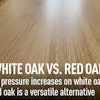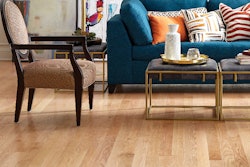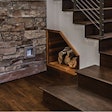We're back with Scott Leavengood of Oregon State University (OSU) talking about wood hardness.
Scott, last week you talked about how, scientifically, the Janka test is designed. Now, this week, tell me about how incredibly inconsistent the results can be!
Well, it certainly doesn't take long for people that work with wood to realize the enormous variability in this wonderful, renewable raw material. Part of that has already been addressed with regards to grain orientation; as discussed earlier, the ASTM Janka hardness test specifies measuring hardness on the radial surface, tangential surface, and end grain. It's logical that there's variability between species, of course-oak is much harder than basswood. But there's also variability within species, and even within an individual board.
So we can assume that hardness varies with grain orientation. But by how much does it vary?
Janka hardness is one of the properties we measure often at the Oregon Wood Innovation Center (OWIC). So we decided to do a little test: We measured Janka hardness on several pieces of wood we had lying around, including a piece of California black oak (which is in the red oak species group).
The published Janka hardness value for this species is 1,100 lbs., which is not quite as hard as the generally accepted level of 1,290 lbs. for northern red oak. We tested this small piece of quartersawn flooring in five places, including a couple of times on or near a knot and got an average hardness of 3,066 lbs.-nearly three times the published value! But again, we tested right on or very near a knot in a couple places. But even without those knotty values, the average hardness is 2,521 lbs., which is well over twice the published value-and the range was from 1,810 lbs. to 2,948 lbs., again, not including the two tests directly on a knot:
Normally we expect higher values on a radial face (quartersawn) than on a tangential face (flatsawn). However, our tests on other pieces didn't show that to be the case. In fact, there was either no substantial difference, or the results went the other way.
Fascinating. Love that oak picture-such amazing variation. Any idea why is there such a difference in hardness even on the same piece for measurements taken just a few inches apart?
It wasn't at all obvious looking at the samples, so we decided to look under the microscope. And right off the bat, I'd like to thank Trina Evensen, one of my Renewable Materials students, for doing all the hardness testing and microscope work.
Trina cut through the indented portions of the California black oak flooring to have a closer look. These are both from the same piece of flooring and, again, about 2 inches apart. Can you see a difference? On the lower piece that rated at 1810 lbs., the wood cells fractured, so the failure was relatively abrupt:
The dots you see inside the circled area are the large earlywood pores (end grain). Compare that to the sample on the top, and you can't see any fractured cells or end grain. These cells simply compressed and deformed throughout the duration of the test, so the hardness value was quite high.
This is the first time I've looked at a hardness test this way, but it does seem to agree with what I've seen many times-when the test values are low, you typically see fractures within the indentations; and when they are high, the indentations are often very smooth-almost like you'd see on metal or plastic.
Fascinating, Scott, thank you! Can we do more?
Absolutely! I'll pull together a few more numbers for you and then you can also send me some samples and I'll get you more tests later this year.
Sounds like a plan, thank you!
































